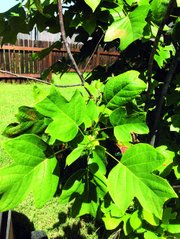Q I had a gooseberry cutting that I got from my grandma's shrub several years ago. I lost it last fall, simply did not realize how dry things had gotten. I am so sad to lose the gooseberry, as my grandma has been gone for several years. She was also very knowledgeable about all sorts of plants. She loved any growing things and transplanted so many plants and trees over the years. The shrub did not produce any berries, but it had small yellow flowers that had a wonderful spicy smell that I love. I am looking to replace this plant, but I cannot tell from pictures which variety my gooseberry was. I don't want to take a guess with this. Can you help me from this (limited) description?
A Gooseberries are in the same genus as currants. While they are not the easiest fruits to grow in Arkansas due to heat and humidity, I do know of gardeners who actually harvest gooseberries annually. I am not an expert on gooseberries and would not even begin to guess which variety your grandmother grew. However there is a shrub that is closely related called the clove currant or Ribes odoratum. It has very spicy-smelling blooms and, rarely, fruits.
Q In a recent article you talked about fertilizers and how you need to fertilize frequently for plants in containers. Is it OK to use regular dry fertilizer granules, or do you have to use a solution?
A You can use a dry granular fertilizer or a water-soluble one. The key is to use it lightly when it is this hot and dry. Make sure with either type that you water well. For the granular forms, keep granules off the foliage and water after applying. With the liquid forms, water the plant first and then use the water-soluble solution. If the plant is too dry it will be burned.
Q I followed your recommendations last spring and used a soil drench compound around my crape myrtles. It appears to have been successful, and I see no indication this summer of crape myrtle scale on my plants. My question is: Do I need to do this again next spring as a prevention or do I wait to see whether there is any indication of a re-infestation?
A Research has shown that one application tends to be good for two years or more, and that recurring infestations may be handled by natural predators. That being said, we really don't know long-term ramifications, since we haven't had the pest in Arkansas that long. I would wait and see if problems reoccur before reapplying. I don't believe in using scale-prevention sprays at this point.
Q Could you please tell me what kind of tree this is? [The reader sent a photo.] I moved to this house in Springdale three years ago. At that time this tree was about 6 feet tall. It is now about 15 feet tall.
A The tree in question is one of our largest shade trees at maturity -- a tulip poplar (Liriodendron tulipifera). It is native to Crowley's Ridge in Cross County. The tree can grow to be 90 feet tall.
Janet B. Carson is a horticulture specialist for the University of Arkansas Cooperative Extension Service. Write to her at 2301 S. University Ave., Little Rock, Ark. 72204 or email her at
jcarson@arkansasonline.com
HomeStyle on 07/28/2018

